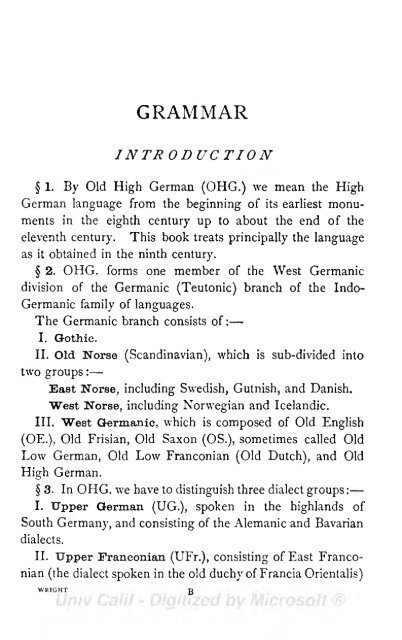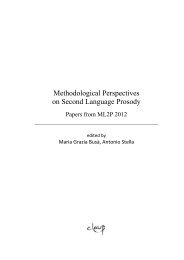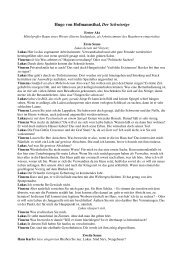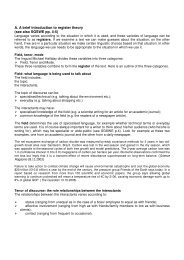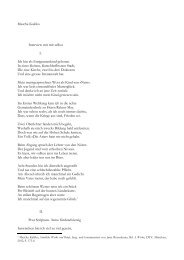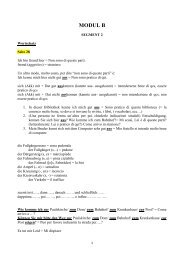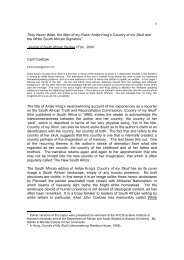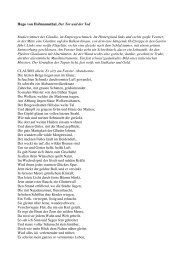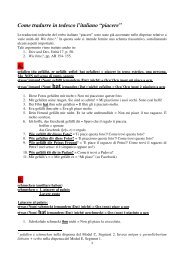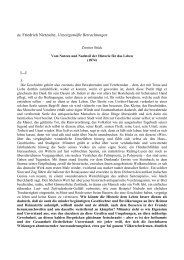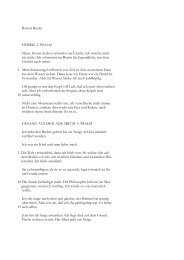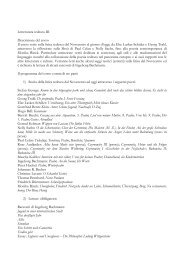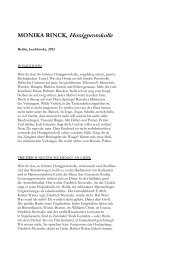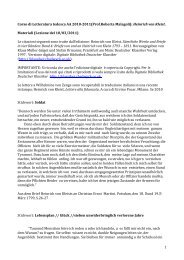- Page 2 and 3: ST~ THE LIBRARY OF THE UNIVERSITY O
- Page 5 and 6: AN WRIGHT
- Page 7 and 8: CLARENDON PRESS SERIES AN OLD HIGH
- Page 9 and 10: SRLF URL PREFACE TO THE FIRST EDITI
- Page 11: PREFACE TO THE SECOND EDITION THE n
- Page 14 and 15: X CONTENTS CHAPTER IV. PAGES THE OH
- Page 18 and 19: 2 OLD HIGH GERMAN PRIMER and Rhenis
- Page 20 and 21: 4 OLD HIGH GERMAN PRIMER B. THE CON
- Page 22 and 23: 6 OLD HIGH GERMAN PRIMER (uv, vu, w
- Page 24 and 25: 8 OLD HIGH GERMAN PRIMER CHAPTER II
- Page 26 and 27: 10 OLD HIGH GERMAN PRIMER wait, OE.
- Page 28 and 29: 12 OLD HIGH GERMAN PRIMER thought,
- Page 30 and 31: j 4 OLD HIGH GERMAN PRIMER followin
- Page 32 and 33: 1 6 OLD HIGH GERMAN PRIMER Lat. sep
- Page 34 and 35: 1 8 OLD HIGH GERMAN PRIMER s 60. Ge
- Page 36 and 37: 20 OLD HIGH GERMAN PRIMER OHG. heil
- Page 38 and 39: 22 OLD HIGH GERMAN PRIMER -5 became
- Page 40 and 41: 2 4 OLD HIGH GERMAN PRIMER sibun, s
- Page 42 and 43: 26 OLD HIGH GERMAN PRIMER LABIAL. D
- Page 44 and 45: 28 OLD HIGH GERMAN PRIMER sp. Lat.
- Page 46 and 47: 3 b OLD HIGH GERMAN PRIMER OE. dfid
- Page 48 and 49: 32 OLD HIGH GERMAN PRIMER wumi, pp.
- Page 50 and 51: f Voiceless Explosives < , . , T \
- Page 52 and 53: 36 OLD HIGH GERMAN PRIMER HG. monum
- Page 54 and 55: 38 OLD HIGH GERMAN PRIMER herza; Go
- Page 56 and 57: 40 OLD HIGH GERMAN PRIMER what has
- Page 58 and 59: 42 OLD HIGH GERMAN PRIMER end of a
- Page 60 and 61: 44 OLD HIGH GERMAN PRIMER Gutturals
- Page 62 and 63: 46 OLD HIGH GERMAN PRIMER MASCULINE
- Page 64 and 65: 48 OLD HIGH GERMAN PRIMER 105. To t
- Page 66 and 67:
tooth, nagal, nail. b. Feminines. 5
- Page 68 and 69:
52 OLD HIGH GERMAN PRIMER B. WEAK D
- Page 70 and 71:
54 OLD HIGH GERMAN PRIMER 120. SING
- Page 72 and 73:
5 6 OLD HIGH GERMAN PRIMER NOTE. I.
- Page 74 and 75:
58 OLD HIGH GERMAN PRIMER C. DECLEN
- Page 76 and 77:
60 OLD HIGH GERMAN PRIMER which are
- Page 78 and 79:
62 155. The following are irregular
- Page 80 and 81:
64 OLD HIGH GERMAN PRIMER Masc. Fer
- Page 82 and 83:
66 OLD HIGH GERMAN PRIMER 3. Posses
- Page 84 and 85:
68 OLD HIGH GERMAN PRIMER PLUR. \ N
- Page 86 and 87:
70 OLD HIGH GERMAN PRIMER. tense, t
- Page 88 and 89:
;a OLD HIGH GERMAN PRIMER Sing. IND
- Page 90 and 91:
74 OLD HIGH GERMAN PRIMER NOTE. i.
- Page 92 and 93:
7 6 OLD HIGH GERMAN PRIMER NOTE. i.
- Page 94 and 95:
jS OLD HIGH GERMAN PRIMER NOTE. i.
- Page 96 and 97:
8o OLD HIGH GERMAN PRIMER preterite
- Page 98 and 99:
OLD HIGH GERMAN PRIMER a. Verbs who
- Page 100 and 101:
Sing. 2. habe haben GERUND. 84 OLD
- Page 102 and 103:
86 OLD HIGH GERMAN PRIMER NOTE. Som
- Page 104 and 105:
88 OLD HIGH GERMAN PRIMER ablaut-se
- Page 106 and 107:
90 OLD HIGH GERMAN PRIMER CHAPTER X
- Page 108 and 109:
92 OLD HIGH GERMAN PRIMER morganllh
- Page 110 and 111:
94 OLD HIGH GERMAN PRIMER 3. II. Lu
- Page 112 and 113:
96 OLD HIGH GERMAN PRIMER thih, bit
- Page 114 and 115:
9 8 OLD HIGH GERMAN PRIMER Thu kneh
- Page 116 and 117:
100 OLD HIGH GERMAN PRIMER Judeisg
- Page 118 and 119:
102 OLD HIGH GERMAN PRIMER uuonatT.
- Page 120 and 121:
104 OLD HIGH GERMAN PRIMER inan ruo
- Page 122 and 123:
io6 OLD HIGH GERMAN PRIMER heilant
- Page 124 and 125:
108 OLD HIGH GERMAN PRIMER ob iz, I
- Page 126 and 127:
HO OLD HIGH GERMAN PRIMER 211. *Jud
- Page 128 and 129:
112 OLD HIGH GERMAN PRIMER mine bru
- Page 130 and 131:
1 1 4 OLD HIGH GERMAN PRIMER d. Mat
- Page 132 and 133:
i6 OLD HIGH GERMAN PRIMER 242. Inti
- Page 134 and 135:
n8 OLD HIGH GERMAN PRIMER aedo miss
- Page 136 and 137:
120 OLD HIGH GERMAN PRIMER (i) Rhab
- Page 138 and 139:
122 OLD HIGH GERMAN PRIMER In g6tes
- Page 140 and 141:
124 OLD HI^H GERMAN PRIMER Ni sfnt
- Page 142 and 143:
126 OLD HIGH GERMAN PRIMER loh mdnn
- Page 144 and 145:
128 OLD HIGH GERMAN PRIMER 'fh bin
- Page 146 and 147:
1 30 OLD HIGH GERMAN PRIMER Sprah t
- Page 148 and 149:
1 32 OLD HIGH GERMAN PRIMER Ih duan
- Page 150 and 151:
134 OLD HIGH GERMAN PRIMER bithurnt
- Page 152 and 153:
136 OLD HIGH GERMAN PRIMER gideilde
- Page 154 and 155:
138 OLD HIGH GERMAN PRIMER Bat er s
- Page 156 and 157:
I 4 OLD HIGH GERMAN PRIMER uue demo
- Page 158 and 159:
1 42 OLD HIGH GERMAN PRIMER denne v
- Page 160 and 161:
144 OLD HIGH GERMAN PRIMER \. 362.
- Page 162 and 163:
I 4 6 OLD HIGH GERMAN PRIMER 1. 368
- Page 164 and 165:
GLOSSARY ABBRE VIA TIONS sm., sf.,
- Page 166 and 167:
ISO OLD HIGH GERMAN PRIMER balwig,
- Page 168 and 169:
152 OLD HIGH GERMAN PRIMER thanan,d
- Page 170 and 171:
154 OLD HIGH GERMAN PRIMER endi, en
- Page 172 and 173:
156 OLD HIGH GERMAN PRIMER vorliez,
- Page 174 and 175:
158 OLD HIGH GERMAN PRIMER gi-lust-
- Page 176 and 177:
i6o OLD HIGH GERMAN PRIMER heilag,
- Page 178 and 179:
162 OLD HIGH GERMAN PRIMER irren, g
- Page 180 and 181:
i64 OLD HIGH GERMAN PRIMER leid, sn
- Page 182 and 183:
i66 OLD HIGH GERMAN PRIMER muot, mu
- Page 184 and 185:
i68 OLD HIGH GERMAN PRIMER riuwa, r
- Page 186 and 187:
OLD HIGH GERMAN PRIMER sparon, wv.
- Page 188 and 189:
oh 172 OLD HIGH GERMAN PRIMER urs =
- Page 190 and 191:
174 OLD HIGH GERMAN PRIMER wiz.z,an
- Page 192:
176 PROPER NAMES Galilea, sf.,gen.


